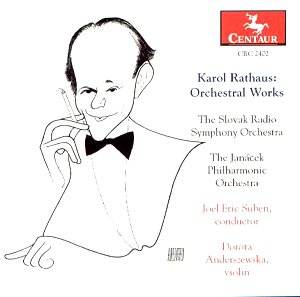A craftsman of exceptional skill Rathausís posthumous
reputation seems to have been as a somewhat daunting exponent
of the Hindemith Counterpoint school, a solecism this disc should
go some way in dispelling. The three major works here, the Suites
for Violin and for Orchestra and the orchestral Serenade come
from a creatively fertile period in his compositional life, 1929-31.
Whilst reflective of their time to some degree they also demonstrate
a striking individuality. When it comes to form and colour and
texture it would be hard to dismiss these works as Weimar eclecticism
much less as a slavish appropriation of Hindemithís method. He
looms large of course but there was always more to Rathaus than
simply walking in othersí footsteps.
Rathaus was born a subject of the Austro-Hungarian
Empire, gravitating like all ambitious young people to Vienna
where he studied with Schrecker. Gifted as a pianist he clearly
saw composition as his calling very early, following his teacher
to Berlin. There he mixed in the youthful demi-monde, meeting
and studied alongside Krenek and Hába, making his life
there. He sensed the mood of the times however and left abruptly
in 1932, ending up in New York via staging posts in Paris, London,
and Hollywood. He didnít like Hollywood at all.
The Suite for Violin (1929) is in four short
conventional sounding movements. The opening movement ("Agitated
and Vigorous") contains signs of Hindemithís counterpoint.
Listen to that remarkable brass counterpoint in particular. There
is a sternness too, a driving insistence that, despite the occasional
moments of lyrical reflection, can sound implacable. But the Rathaus
lyricism is one tinged with hooded reserve as the Andante second
movement well displays, with its shifting string solo lines. This
also lends an emotionally euphonious element to his writing. He
experiments with rhythm as well, introducing an unlikely but apt
(Rathaus was born Tarnopol, in what is now Poland) Polonaise in
the frisky Capriccio which he also decorates with a nightclub
banjo twanging an independent line. The gestures are folk-like;
the controlling hand knowingly sophisticated. The finale is bustling
and colourful; chirping clarinets and a very brittle sign-off.
Unlike some of his contemporaries Rathausís orchestration admitted
a deal of light and colour and thereís always something to tease
the ear in his scores.
The Suite for Orchestra followed the following
year. Less distinctive than the earlier work perhaps, itís a bustling
affair with a full panoply of fugal and counterpoint development
in the opening movement. A rather cool slow movement follows but
the best movement is the third in which a sliver of an Andante
(spectral voicings) leads to an ostinato-rich and energetic Allegro
section. This has a thematic and virtuosic role for solo piano
that adds yet greater colouristic resources to the score. This
most unusual and unexpected interjection makes no reappearance
in the finale which for all its apparent power generates considerable
heat. Itís in the form of a march but at a controlled tempo, splendidly
orchestrated. It makes its, perhaps ominous, point with well-directed
effect. The Serenade of 1931 was the last work he wrote before
leaving for Paris. This Goodbye to Berlin certainly casts its
eye over the bars and night haunts of Weimar. The first movement
sports motoric bubble before introducing us to the sound of a
jazz band (saxophone and drum kit) and a dash of raucous abrasion.
The Moderato second movement features the saxophone once again
but this time singing a long cantilena - artist now following
the previous movementís artisan. There are interjections from
the tightly muted dance-band trumpets and the massed, swaying
strings. Neo-classical sprightliness Ė never whole-heartedly embraced
Ė also puts in an appearance in the contrastive central section.
The driving Ländler finale is bold, employs the piano and
gruffly takes everyone by surprise. Rathaus signs off with a pianissimo
staccato note Ė the rest is silence. The disc ends with the little
Polonaise Symphonique, a product of his New York years. Itís an
eventful, romantic processional with good block entries for brass
and an air of nobility about it. It was first performed by Rodzinski
and the New York Philharmonic-Symphony in 1943.
Thereís not much air in the Concert Hall of Slovak
Radio in Bratislava but then a burnished cushion would not have
been Rathausís ideal medium. Heís certainly not spiky or brittle.
He is surprisingly accommodating of traditional neo-romantic devices
avoiding the luxuriantly sentimental and not much given to extended
simplicities. The notes, which are clear-eyed and full of precision
(Rathaus specialities), cite his pupil, Leo Craft, who has some
apposite things to say. A most thought-provoking and entertaining
disc.
Jonathan Woolf
